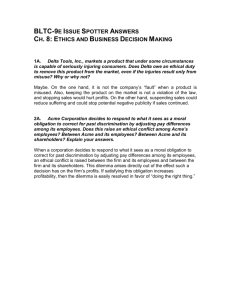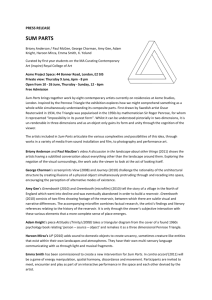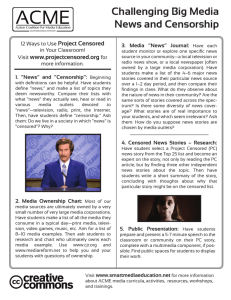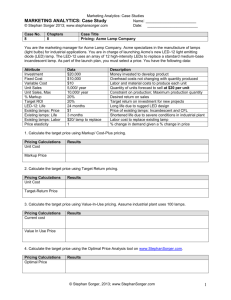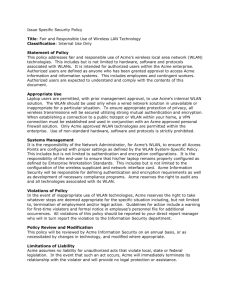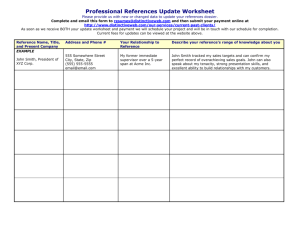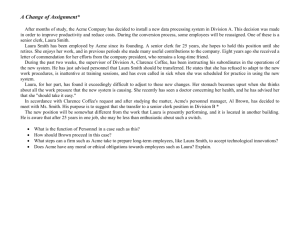FAR-Compliant PriceCost Analysis Techniques and Methodologies
advertisement
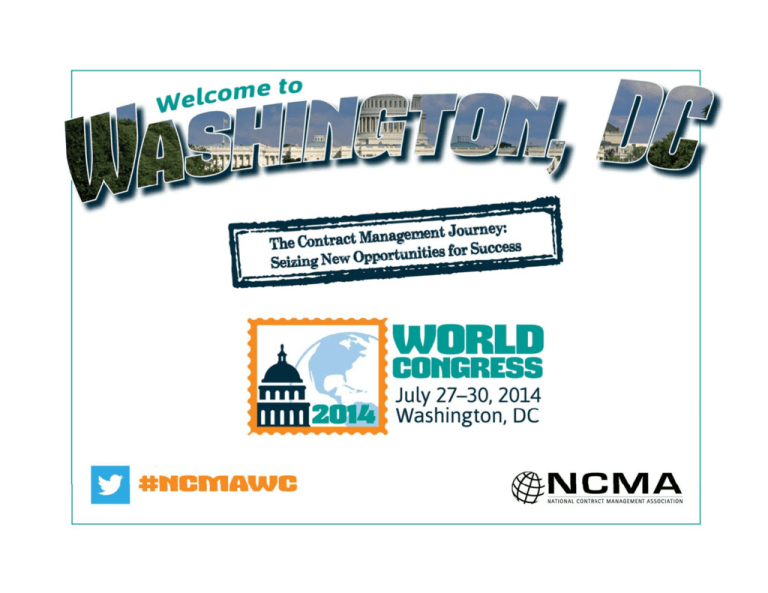
FAR Compliant Price/Cost Analysis Techniques and Methodologies Breakout Session #C09 Mitchell A. Bednarski, C.P.M., CPSM, CPCM Subcontracts MGT Staff, Lockheed Martin Kevin L. Smith, CPA Cost Analysis Mgr, Lockheed Martin Date July 28, 2014 Time 4:00P to 5:15P Presentation Overview • Price/Cost Analysis I/O Diagram (inputs and outputs) • Receive proposal • Verification of FAR Compliance (proposal adequacy) • Evaluation of Proposal • Fact-finding, Cost Analysis, Price Analysis, Tech Evaluation, Final Report (support DCAA Audit) • The Elements of Price Analysis (Mitch) • Overview/Definition and FAR Requirement/Exemptions • Price Analysis Techniques • The Elements of Cost Analysis for suppliers > 700K (Kevin) • Overview/Definition and FAR Requirement/Exemptions • The Elements of a Technical Evaluations (Kevin) • Overview/Definition 3 Price & Cost Analysis I/O Diagram PROPOSAL COST / PRICE ANALYSIS FINAL REPORT Price Analysis (Mitchell Bednarski) ACME Pro Forma Proposal Cost Analysis (Kevin Smith) Technical Evaluation (Kevin/Mitch) 4 Key Definitions • Price Analysis – Evaluation of Price without regard to cost elements or profit • Cost Analysis – Evaluation of cost elements and profit • Cost or Pricing Data – Data used by the subcontractor to develop there estimate up to the date of agreement on price (date of certification) • Fact Finding – Gathering factual and judgmental data for Cost Analysis Evaluation 5 “Fun Facts” How many dots are on the arcade screen for PAC-Man (game)? 6 “Fun Facts” There are 240 dots on an arcade Pac-Man game 7 Mitchell Bednarski PRICE ANALYSIS 8 Requirements for Price Analysis – Objective (Fair and Reasonable) • FAR Part 15 Contracting by Negotiation • Subpart 15.4 Contract Pricing • 15.403-4 – Requiring Certified Cost or Pricing Data • FAR 15.408 Table 15-2 • TINA – Truth In Negotiations Act PL 87-653 • FAR 12.209 – Commercial Item Price Reasonableness • FAR 13.106 – Evaluation of Quotes or Offers • FAR 15-404-1(b) – Proposal Analysis Techniques • www.acquisition.gov/far/ 9 Price Analysis FAR 15.404-1 Proposal Analysis Techniques FAR 15.404-1(a)(2) : Price Analysis shall be used when cost or pricing data are not required. FAR 15.404-1(b)(1) : Price Analysis is the process of examining and evaluating a proposed price without evaluating its separate cost elements. FAR 15.404-1(b)(2) : Price Analysis techniques include but are not limited to: • Comparison of Competitive Bids & Prices • Comparison of Proposed Price with Prior Procurement History • Comparison of Prior Quotations • Comparison of Published Price Lists • Prices Set by Law or Regulation • Similar Item Price Comparison • Rough Yardstick Comparisons 10 Hierarchy of Price Analysis Techniques Primary Comparisons Competitive Comparisons Competitive Offers Adequate in Number and Quality Published Price Comparisons Established Catalog Prices Established Market Prices Prices Set by Law or Regulation Secondary Comparisons Previous Contracts / POs Prior Quotes Pricing Data for Similar Items Market Data Cost Estimating Relationships Independent Estimates Auxiliary Techniques Value Analysis Visual Analysis Source ASPM # 1 11 Price Analysis Adequate Price Competition/Comparing Competitive Prices: • Competition between 2 or more responsible bidders. • Offers are submitted that are responsive to terms of the solicitation. • Independent competition between bidders for award. • Successful Offeror is selected based on either: • Best value where price is a substantial source selection factor. • Provides lowest price and the price is reasonable Follow-on to Price Competition • Comparison of current proposed prices to prior award competitive prices. • Current price must be same as previous award prices paid. • Price differences due to inflation and quantity variances can be considered. • Must determine that price is still competitive in the market. • Must be within 2 years of prior award. 12 Price Analysis Comparing Established Market Prices • Established market prices may be compared to bidders price. • Market Prices: • Based on current sales price for supplies and services. • Established in the course of ordinary and usual trade. • Substantiated by data from sources independent of bidder • Substantiation of Established Market Prices • Review market data: Industry Publications, Pricing Indexes, Market Periodicals for data on products, prices, market trends and advances in technology. • Use newspapers, trade journals and market indexes to validate assumptions and the need for adjustments • Proposed prices are compared to prices identified through market research along with analysis of similarities and differences found through the market research process. 13 Price Analysis Comparing Established Catalog Prices for Commercial Items • Comparison of established catalog prices may be performed if the following conditions exist: • Item has been sold, leased, or licensed to the general public or • Item has been offered for sale, lease or license to the general public • Item evolved from item sold, leased or licensed to general public. • Confirm price is based on above criteria & attach data to price analysis. • Attach copy of catalog, price list or confirmed record page that shows: • Item price • Date of established record used in price analysis • If copy of record not available document reason in price analysis • Document discount from catalog price with copy of page from catalog and address basis for discount being fair and reasonable. • Document basis for determining catalog price as fair and reasonable by establishing validity of catalog. 14 Price Analysis Comparing Prices to Established Catalog Prices of a Similar Catalog or Market Priced Item, including GSA Federal Supply Schedule Prices. • Price of an item or class of items which are not catalog or commercial items may be compared to similar items with established catalog or market prices. • GSA prices for similar items may be considered market pricing. • Identify and justify any price difference without resorting to cost analysis. • In comparing price to a catalog price, price list, schedule or other verifiable and established record: • Attach copy of record page that contains item price and date of the established record to the price analysis. • If copy of record is not available document reason for unavailability in price analysis. • In comparing price to established market prices of other items: • Substantiate the market with data from sources independent of Offeror. 15 “Fun Facts” The Sultan of Brunei is one of the world’s richest men. How many rooms are in his palace? 16 “Fun Facts” The Sultan’s palace contains 1,788 rooms and is larger than Vatican City. 17 Price Analysis Comparing Historical Prices of the Same or Similar Supplies and Services (Previously Proposed Prices or Buy History) • Perform price analysis by comparing current proposed price with: • Previously proposed prices or • Prices in previously awarded contract for same or similar supplies or services. • Information can be obtained from proposals or purchase history. • Use this analysis method for Previously Proposed Prices: • Identify proposal number, item, date of proposal, quantity proposed and the price proposed. • Use this method for purchase (buy) history: • Identify previous contract number, item, date of contract award, order quantity and the price paid. • For comparison to be valid, identify, consider & document item or market differences that may significantly affect price. • Reconcile differences and compare prior price with new price. 18 Price Analysis Comparing Prices with Independent Estimates. • Compare Offeror’s prices with independent estimates. • Internal in-house estimates or Third Party estimates. • Estimate developed without access to priced offers. Applying Rough Yardsticks • Estimate prices based on relationship of price to one or more physical or performance characteristics. • Validate yardstick is appropriate for price being analyzed. • Apply rough yardsticks such as dollars per pound, horsepower, etc. • Identify significant inconsistencies that warrant additional pricing inquiry Long Term Agreement / Group Purchasing Agreements / etc. • Perform Price Analysis to demonstrate prices remain competitive in the market place. 19 Price Analysis – ACME CAR Comparison with Similar Item Price History Historical Pricing Data: Item: ACME Car #1 Quantity: 20 each (PO M5J2 dated 07/2012) Unit Price: $320,000.00 each (Price History) Contract: July 2012 Current Requirement Item ACME Car #2 8% more complex Order Quantity: 10 each Unit Price: $361,565 (Proposed) Estimated Contract Award Date: July 2014 Price Improvement Curve: 95% Price Analysis Price: $371,658.85 20 Price Analysis – ACME Car NRE Prior Procurement History Similar Item PO M5J2 dated 07/2012 Item: NRE (ACME Car Model #1) Quantity: 1 lot NRE Price: $1,525,000.00 Current Proposed Price: $1,884,349.00 Quantity: 1 lot NRE Estimated Contract Award Date: 07/2014 Complexity: 25% More Complex Price Analysis Price: $1,956,544.23 21 “Fun Facts” What is the dollar value of a mint condition copy of the comic book Superman #1? 22 “Fun Facts” $ 580,000. A total of 200,000 copies were printed in 1938 and sold for 10 cents each. 23 Kevin Smith COST ANALYSIS FAR 15.404-1 PROPOSAL ANALYSIS TECHNIQUES. (A) GENERAL. THE OBJECTIVE OF PROPOSAL ANALYSIS IS TO ENSURE THAT THE FINAL AGREED-TO PRICE IS FAIR AND REASONABLE. FAR 15.404-1(A)(3) REQUIRES THE GOVERNMENT TO PERFORM A COST ANALYSIS TO EVALUATE THE REASONABLENESS OF INDIVIDUAL COST ELEMENTS WHEN CERTIFIED COST OR PRICING DATA ARE REQUIRED. THIS REQUIREMENT IS FLOWED TO ALL LEVELS OF THE SUPPLY CHAIN WHEN PROPOSING AGAINST OR PROCURING ITEMS UNDER A GOVERNMENT PRIME CONTRACT. 24 Cost Analysis Flow Summary FAR Requirement Fact Finding – at Vendor Facility Other Direct Costs Rates & Factors Direct Material Direct Labor Profit / Fee 25 Cost Analysis Report Requirements for Cost Analysis – objective (Fair and Reasonable) • www.acquisition.gov/far/ • FAR Part 15 Contracting by Negotiation • Subpart 15.4 Contract Pricing • • 15.402 Pricing Policy “Shall obtain Cert Cost or Pricing when required by 15.403-4 • 15.403-4 Requiring Certified Cost or Pricing Data; Over $ 700K • FAR Part 31.000 Contract Cost Principles and Procedures FAR 15.408 Table 15-2 – Instructions for Submitting Cost/Price Proposals When Cert Cost or Pricing Data is Required • TINA – Truth In Negotiations Act PL 87-653 – requires execution of Certificate of Current/Cost Pricing Data 26 FAR 15.403-1 Exceptions to Certified Cost of Pricing Data • Less than $ 700K Acquisition (proposal) • Price is based on Adequate Price Competition • Price is set by law or regulation • When a Commercial item is being acquired • When a waiver has been granted (Contracting Officer) 27 Cost Analysis Preparation • Obtain copy of Vendor Proposal – Preferably before fact finding • Set up fact finding trip to Vendor (time for Plant Tour) • Compare Period of performance in Vendor Proposal to RFP • Compare Validity date of Proposal to RFP request • Obtain Historical Data (Prior Cost Analysis / PO History) • Price Analysis • Request Technical Evaluation (NRE Hours, Complexity factors, etc) • Keep in Mind – End Users (Internal Procurement, DCAA Audit, External Customer – Fair and Reasonable Conclusion) • DCAA may request a detail walk through of your Cost Analysis Report 28 Fact Finding • Walk through Vendor Proposal – Cost Elements - Rationale • Obtain a clear understanding of all elements • Objective is to obtain further support / understanding / not criticize • Create a list of open items/questions • Review / update daily if needed • Identify areas that need further support/clarification • Example – Adequacy of sub tier supplier proposals • Sub-tier Cost Analysis schedules • Dates to clear scope items (new testing requirements) • Is Vendor subject to FAR 30.000; CAS – Cost Accounting Standards • Tour Factory– find your products - observe (heads, layout, etc) 29 Proposal Elements • Direct Material Costs (Bill of Material) • Direct Labor - Skill mix and appropriateness of DL Hours • Other Direct Costs (Travel, Services, Start Up, Transportation, Other Material, Outside Testing, Outside Processing – anodizing, etc) • Profit (DOD Weighted Guidelines – exclude COM from calculation) • Special Tooling/Test Equipment • Rates and Factors /Forward Pricing Rates (If No Audit Rights) • Obtain in writing – statement of no audit rights • Request DCAA Audit through cognizant DCMA office 30 “Fun Facts” For how many consecutive weeks was Pink Floyd’s The Dark Side of the Moon on the Billboard 200 album chart? 31 “Fun Facts” 741 Weeks – Over 14 Years straight 32 ACME Car Proposal - FFP ACME High Performance CAR Recurring Non‐Recurring Total Cost 10 units 10 $ 2,500,000 Per unit Cost Elements Material Costs Direct Labor Assembler Bonding Inspection Final Assy subtotal $ 250,000 Rate Hours $ 20.00 10 $ 200 $ 19.00 2 $ 38 $ 18.00 1 $ 18 $ 17.00 4 $ 68 Rate Non Recurring Labor Draftsman $ 30.00 Engineer $ 80.00 Test Engineer $ 60.00 Non Recurring Material Travel Mfg Overhead 150.00% Total Mat, labor & Ovhd $ 2,000 $ 380 $ 180 $ 680 $ 3,240 $ 32,400 Total $ 2,500,000 $ 32,400 Hours 1000 2000 3000 $ 30,000 $ 160,000 $ 180,000 $ 400,000 $ 20,000 $ 30,000 $ 160,000 $ 180,000 $ 400,000 $ 20,000 $ 4,860 $ 48,600 $ 555,000 $ 603,600 $ 258,100 $ 2,581,000 $ 1,345,000 $ 3,926,000 G & A 20.00% $ 51,620 $ 516,200 $ 269,000 $ 785,200 Mfg COM G & A COM 0.0005 0.0005 $ 1.62 $ 25.81 $ 16 $ 258 $ 185 $ 134.50 $ 201 $ 393 Profit 16.73% $ 51,818 $ 518,176 $ 270,030 $ 788,206 $ 3,615,650 $ 1,884,349 $ 5,500,000 Total Sell Price (10 Cars) Bottom line “Sell Price” To be used for Price Analysis 33 Direct Material Costs • FAR 15.408, Table 15-2 requires the Offeror to provide a consolidated priced summary of individual material quantities (typically referred to as a Consolidated Bill or Material, or CBOM) included in the contract being proposed. The proposal should also include Bills of Material (BOMs) at the line item level as well. The CBOM and line item BOMs should include raw materials, parts, components, assemblies, subcontracts and services to be produced or performed by others. • Material items proposed must include: • Source, Quantity, and Cost • The basis of estimate (BOE) which describes the basis for proposed material costs 34 Direct Material Costs • Consolidated Bill of Material (DCAA focus) • Verify Parts and Qty’s to drawing’s • Identify any recent/upcoming changes • Price Basis of BOM (quotes, PO History) • Trace to quotes/PO’s/estimates/inventory system/etc. • Material Escalation (Basis/History) • Obtain basis / historical experience / Indices / etc. • Material Scrap (Basis/History) • Material Factors/Overhead (Basis/History) 35 Direct Material Costs – ACME CBOM Part Part Qty Total Number Description (ea) Qty price (ea) basis 1001 Frame 1 10 $ 60,000 Quote 1002 Engine 1 10 $ 100,000 Quote 1003 Body 1 10 $ 82,000 Quote 1004 Wheels 4 40 $ 2,000 PO History Grand Total Material 36 Commercial Sole Source Competition Competition Vendor Frame for Life Inc. Rolls Royce Cadilac Composites Spin City Inc total $ 750,000 $ 850,000 $ 820,000 $ 80,000 $ 2,500,000 Direct Material Costs (Cont.) • Over $ 700 K Suppliers in CBOM (Rolls Royce) • Sole Source (Sub-tier C/A Required) • The Only Source – only one M. Jordan • Single Source (Sub-tier C/A Required) • Only source on drawing/customer directed • Competitive (obtain supplier bids, RFP, etc.) • Commercial (obtain supporting evidence); FAR 2.101 • DCAA will sort CBOM by supplier – add up suppliers 37 Direct Material Costs (Cont.) • DCAA Focus Items • Consolidated BOM for max qtys • Identify every line item with supplier name • Commercial Assertions • Detailed Sales data (customer, sales $, etc.) • Over $ 700K Suppliers (basis for each supplier competitive, commercial, sole source – need C/A) • All factors must be visible (show calculations) 38 Commerciality • FAR 2.101 – Commerciality requirements • Unmodified Commercial Items or Components • Any item, other than real property, that is of a type customarily used by the general public and has been • Sold, leased or licensed to the general public, or • Has been offered for sale, lease or license • Some steps to verify Commerciality • Analyst should obtain Verification of sales history to source data (sales by customer, by qtr or year) • Verify item to an exiting catalog/price list Example – 4 by 8 sheet of plywood 39 Commerciality – Con’t • FAR 2.101 – Commerciality requirements • Item Evolved from Commercial Item • The proposed item does not currently exist in the market place • Defined as any item that evolved from a commercial item through advances in technology or performance and that is not yet available in the market place, but will be in time to satisfy the delivery requirements under the USG solicitation • Example – Apple I phone 6 • Verify Sales history and modification support 40 Commerciality – Con’t • FAR 2.101 – Commerciality requirements • Modified Commercial Item • Commercial Item currently Exists/Currently sold in the market place • Modification is minor to existing product • Modification must not have a substantial impact on the non governmental function • Does the base item qualify as commercial item • Example - Commercial aircraft actuator with minor modifications being proposed for use on a military aircraft 41 “Fun Facts” Of the 538 electoral votes possible, how many did Ronald Reagan receive in the 1984 presidential election? 42 “Fun Facts” 525 – Reagan defeated Walter Mondale in the most lopsided presidential election in U.S. History President Obama received 365 of 538 electoral votes in 2008 43 Direct Labor • Understand Basis of the Direct Labor hours Estimate • All variables – yield factors/scrap/etc. • Projections from actual history • Obtain historical actuals by bid category • Labor Standards • Obtain basis / frequency of updates / reconciliations • Engineering Estimate/Etc. • Obtain vendor basis of estimate details • Improvement Curve • Lean Events / Improvements 44 Direct Labor - ACME Basis of ACME Direct Labor Hours Direct Labor Rate Hours Assembler Bonding $ 20.00 $ 19.00 10 2 Final Assy $ 18.00 4 FY 2013 Actuals for similar product line (AMCE Go Carts 1.20 complexity factor) Based on Labor Standards for Bonding Dept FY 2013 Actuals for similar product line (AMCE Go Carts 1.20 complexity factor) Auditor would validate actual hours by category in ACME's labor reporting system (SAP) and the detail support behind the 1.20 complexity factor (rationale, BOE, Eng Tech Evalution Input, etc) Auditor would review labor standards/basis of standards/like kind parts produced 45 Direct Labor (Cont.) • Obtain DL History (several years) • Identify Period of Performance • Are hours bid in line with Statement of Work? • Project forward based on history by bid category • Apply learning curve if applicable • Engineering Technical Evaluation • DCAA Concerns: • Detailed Basis Of Estimate (Documentation, Calculations, etc.) • Missing calculations (show the math) 46 Other Direct Costs • Understand Basis of estimate • Travel Costs (history/factor/proposed by trip/etc) • (Trips; location; heads; air fare; lodging; per diem) • Trace to supporting travel requirements • Reference Joint Travel Reg’s (JTR) for Government Contracts / Travelocity Air Fare’s • Other Material Items (outside services; quotes/history) • Engineering Estimates/Etc. • Special Tooling & Test Equipment 47 ODC – ACME Travel ACME Proposed Travel Trips From To Year Per Diem Food/Inc Car # of Travelers Days sub total Air Fare Air Fare Tot Grand Total 1 DFW Boston 2014 229 71 40 5 3 $ 1,020 $ 5,100 $ 462 $ 2,310 $ 7,410 2 DFW Albany NY 2014 111 61 40 5 3 $ 636 $ 3,180 $ 500 $ 2,500 $ 5,680 3 & 4 DFW Org County 2014 133 71 40 5 3 $ 732 $ 3,660 $ 650 $ 3,250 $ 6,910 $ 20,000 Analysis of TRAVEL costs 1) Verify need for Trips / head count / number of days / locations 2) Compare Per diem to GSA.gov per diem rates 3) Verify reasonableness of aire fare (travelocity 14/7 day trip lead time to destinations) 48 Profit / Fee • Understand Basis of estimate • Historical Fee for Recurring Contracts • Verify Type of Contract (FFP, CPIF, etc.) to RFP • DOD Weighted Guidelines • Develop Profit Model per – DFARS 215.404-71 DFARS 215.404 • http://farsite.hill.af.mil/regpdf/dfars/215/215_4.pdf 4-71 • Contract Pricing Ref Guide Volume 3 Chapter 11 Profit Model • @ http://acc.dau.mil/cprg • Variables include performance risk, contract type risk, facilities capital employed, Cost efficiency 49 Profit - ACME ACME Proposed Profit 16.73% Cost Analysis Recommendation 15.00% Dollars $ 788,206 $ 706,462 Sample DOD worksheet model - 50 Sample DOD Worksheet “Fun Facts” Stevie Wonder was the youngest male soloist to have a # 1 U. S. single. How old was he when he achieved this feat? 51 “Fun Facts” 13 years old in 1963 with Fingertips 52 Rates & Factors • Understand Basis of estimate • Calendar Year or Fiscal Year Rates • Rates based on forward pricing agreement – obtain approval letter • If no “Audit Rights” – Obtain Denial letter in writing from vendor •Request DCAA Audit 53 Rates & Factors • If you have - Audit Rights • Perform Period of Performance Audit • Overhead / G & A Rates • Direct Labor Rates by Category • Other Factors (Travel/Material/etc.) • 3 Years of historical financial statements • Obtain 3 years of historical rate data • Pool & Base – vouch back to Acct System (Trial Balance, GL, etc) 54 Rates & Factors • Select accounts -Trial Balance for testing for the most recent completed fiscal year • Trace back to supporting data (invoices, purchase orders, leases, utility bills, etc) • Obtain forecasted rates, sales, head count • What percent of sales is your company? • Direct Labor rates – trace back into labor system – select sample of employees • Compare Forecasted accounts to history 55 Rates & Factors - ACME ACME Proposed Rates Direct Labor Assembler Bonding Inspection Final Assy Draftsman Engineer Test Engineer Mfg Overhead Rate $ 20.00 $ 19.00 $ 18.00 $ 17.00 $ 30.00 $ 80.00 $ 60.00 150.00% G & A 20.00% Mfg COM G & A COM 0.0005 0.0005 1) Obtain Basis of the proposed Rates ‐ DL based on 12/31/2013 actual rate Verify Rate Calculations Trace to payroll summary/detail sheets Sample a few employees ‐ trace to time cards/HR records/paystubs/etc. Obtain 3 or more years of history to determine actual DL increases 2) verify pool/base data/calculation ‐ history and forward pricing rates perform period of performance audit on rates judgementally select items for testing/vouch to supporting documents remove unallowables validate cost of money calculation/trace to support schedules 56 Rates & Factors Cont. • Executive Salary Cap limit • $ 952,308 as of 1/1/2012; DCAA Contract Audit Manual 6-414.8; www.dcaa.mil/cam • COM – Reference Guide Volume 3 Chapter 10 @ http://acc.dau.mil/cprg • Other Factors (Travel/Material/etc.) Cost Of Money • Cost Accounting Standards • Walkthrough CASB disclosure statement • Have vendor fill out Accounting System Guide – How do they charge items – outlines expense pools – direct versus indirect costs, etc. 57 Rates & Factors Cont. • FAR 31.201-6 Unallowable Costs • Entertainment Expense • Bad Debt Expense • Donations and Contributions • Automobile cost for personal use • Advertising – unless contract requires • Alcohol • Unallowable costs should be excluded from rates • Small Business – review American Express/Visa for personal items – dry cleaning/grocery/etc. 58 Develop Fair and Reasonable Opinion – based on all data collected • On Individual Cost Elements • Document basis of Fair And Reasonable • Show Audit Trail of support data • Discuss Proposed versus Cost Analysis • For Each Cost Element • Make notes along the way on items that you can challenge in negotiations • Document opinion in the Cost Analysis Report 59 Cost Analysis Report • Final Report for file (pdf format) • Distribute to Estimating • Procurement (Subcontract Manager) • DCAA will Analyze • End Item Customer will Analyze • Support Negotiations – with challenges 60 Cost Analysis Report – DCAA Concerns • DCAA may request a walkthrough • Adequacy of Vendor Proposal • Table 15-2 Adequacy Checklist • If a specific Cost Element is not well documented – DCAA asks questions • Trace BOM parts back to drawing • Adequate support for over $ 700K Sub tier suppliers (Proposal, Cost Analysis) 61 “Fun Facts” In what year did Nadia Comaneci score the first perfect 10 in Gymnastics? 62 “Fun Facts” The 14-year old Nadia scored 7 perfect 10’s at the 1976 games (Montreal, Quebec, Canada). 63 Kevin TECHNICAL EVALUATION 64 Technical Evaluation Preparation • Obtain copy of Vendor Proposal • Must have working knowledge of RFP, Statement of Work • Statement of Work – Engineering/Manufacturing • Verify that vendor is working to most current revisions • Were the correct documents flowed to ACME (vendor) • Compare Period of performance in Vendor Proposal to RFP • Example – Analyze labor spread over POP • Request Historical Data (NRE actual labor hours by task/category) • Request Historical Travel / Other Direct Material / Actuals • Are there any Changes in Technology and documentation • Adequate Work Instructions – any upcoming lean events? 65 Elements to be Analyzed • Review Labor Functions/Labor Categories • Analyze Tasks proposed to Statement of Work/Performance Spec. Develop a Matrix that ties to SOW/ Performance Spec • Discrete Tasks as proposed based on SOW/Performance Spec.) • Analyze hours by function by task • Review Level of Effort tasks (Program Office, Mfg Eng support) • Material – Parts List – BOM Review (part number, qty’s, QA reqmt’s) • Test equipment / Inspection equipment / etc. • Hard Tooling/Soft Tooling – Tool proofing • Non recurring tasks evaluation based on SOW/Performance Spec. • Non recurring material evaluation based on SOW/Performance Spec. 66 ACME Car Proposal ACME High Performance CAR Recurring Non‐Recurring Total Total Cost 10 units 10 $ 2,500,000 $ 2,500,000 Per unit Material Costs Direct Labor Assembler Bonding Inspection Final Assy subtotal $ 250,000 Rate Hours $ 20.00 10 $ 200 $ 19.00 2 $ 38 $ 18.00 1 $ 18 $ 17.00 4 $ 68 Rate $ 2,000 $ 380 $ 180 $ 680 $ 3,240 $ 32,400 Non Recurring Labor Quality Mfg Eng $ 30.00 1000 Engineer $ 80.00 2000 Program Mgmnt $ 60.00 3000 Non Recurring Material Travel 4 Trips Mfg Overhead $ 30,000 $ 160,000 $ 180,000 $ 400,000 $ 20,000 $ 30,000 $ 160,000 $ 180,000 $ 400,000 $ 20,000 $ 4,860 $ 48,600 $ 555,000 $ 603,600 Total Mat, labor & Ovhd $ 258,100 $ 2,581,000 $ 1,345,000 $ 3,926,000 G & A 20.00% $ 51,620 $ 516,200 $ 269,000 $ 785,200 Mfg COM G & A COM 0.0005 0.0005 $ 1.62 $ 25.81 $ 16 $ 258 $ 185 $ 134.50 $ 201 $ 393 16.73% $ 51,818 $ 518,176 $ 270,030 $ 788,206 $ 3,615,650 $ 1,884,349 $ 5,500,000 Profit 150.00% $ 32,400 Hours Total Sell Price (10 Cars) 67 NRE Hours - Quality • Understand the vendors Basis of Estimate for ACME 1,000 hours • Drive down to detail tasks as required in Statement of Work • Mandatory inspection points • Parts Library (additional parts for analysis after production) • Special Processes / Special Handling per the SOW • Sub tier vendor Quality Audits • Product Line Validations 68 NRE Hours - Engineering • Understand the vendors Basis of Estimate; for 2,000 hours • Drive down to detail tasks as required in Statement of Work / Performance Specifications • Number of drawings required for new ACME Car • Size/Complexity of Drawings • Bill of Materials (complete, size, sub tier requirements, etc.) • Obsolete parts (plan, tracking, etc.) • Configuration Management • Time to support customer meetings / Production Readiness Review / Critical Design Review. • Mfg Engineering support - develop work instructions 69 NRE Hours – Program Management • Understand vendors Basis of Estimate; for 3,000 hours • Drive down to detail tasks as required in Statement of Work • ACME program is 20 months (1 full time head) • Program Reviews / Kick off meetings • Support weekly telecom meetings • Attend Production Design Review / Crictical Design Review • Develop Master Schedule • Product Line Validation Support • Cost and Schedule Report • Other Specific Contract Line Item tasks (weekly reports, etc) 70 NRE Material • Understand the vendors Basis of Estimate; for $ 400,000 • Drive down to detail support as required in Statement of Work • ACME requires additional tooling to start production • $ 350,000 competitive quote from supplier XYZ • Determine if subject tooling is truly needed / required • Are quantities sufficient to support production rate • • ACME bids $ 50,000 in material for Outside Product Testing • Is subject testing needed/required per Specifications? • Are the proposed tests the right tests to be performed? • Is testing vendor capable? Did ACME overlook (under propose) any material items? 71 Travel • Understand the vendors Basis of Estimate each trip • Drive down to detail support as required in Statement of Work • • Program Review in Boston – required per SOW? • Are the number of people/skill set adequate? • Are the number of days adequate per SOW requirements? • Are the trips adequate (location, duration, purpose, etc) • Any considerations for follow-on activities (action items) • Did ACME propose any excessive trips Did ACME overlook any requirements (under/over propose)? 72 Engineering Technical Evaluation Report • Draft detail report by element comparing proposal details to the Technical Evaluation. • Summarize data for input into the Cost Analyst Report • Identify min/max positions (negotiations) • Identify proposed areas of over/under statement • Identify any omissions / scope changes • Identify effort out of scope with SOW • Distribute report to Sub-Contract Administrator and Cost Analyst 73 “Fun Facts” Does anyone have a Birthday today? July 27, July 28, July 29, July 30 74 “Fun Facts” July 27 – Maureen McGovern (singer – Got to Be a Morning After) 1949 July 28 – Jacqueline Lee Bouvier Kennedy Onassis (1929) July 29 - Dictator Benito Mussolini (1883) July 30 Arnold Schwarzenegger (1947) 75 QUESTIONS? 76
